#Scrape Data from Netflix App
Explore tagged Tumblr posts
Text
Title: Netflix App Data Scraping Services - Netflix App Data Collection
iWeb Data Scraping provides the best Netflix app data scraping services to scrape episodes, shows, ratings, etc., across the USA, UK, Canada, India, Australia, Germany, France, UAE, Belgium, and Italy. We make use of the latest technology for Netflix app data Collection.
#Netflix App Data Scraping Services#Netflix App Data Collection#Scrape Data from Netflix App#Netflix Video App Data Scraping
0 notes
Text
[Image Description: A series of screenshots.
Image 1: A post on r/Ao3 on Reddit by u/EasterKingston. The post is titled "'Netflix of audiobooks' scrapes thousands of fanworks off Ao3 without permission. Yours, likely, included."
Image 2: The preview for a website titled word-stream. The page is titled "You & Me & Holiday Wine - WordStream".
Image 3: A screenshot from the website WordStream. The word "ekingston" is entered into the search bar. There are two results. One named "You & Me & Holiday Wine" and the other named "The Shape of Soup". Both have over 80 thousand views.
Image 4: Another screenshot from the same site. The name "Kara Danvers" is entered into the search bar. There are twenty results from a variety of authors that fill up the page.
Image 5: A sent text reading: "I followed you here from Reddit, where I was made aware of the truly awesome work your project Copyknight has been doing. I just discovered the website/app word-stream.com today-it's a site that's seemingly scraped thousands of works off ao3 and offers audiobook versions of them, presumably for a fee. It looks like it only went live in October, and I don't see much chatter about it (or contact information) anywhere. I was wondering if you'd heard from it/could offer advice on how to go about getting our works taken down?"
Image 6: A screenshot of a contact form being filled out. The form is on transformativeworks.org and appears to be a contact form. The subject is "New app committing grand-scale copyright infringement of works hosted on Ao3". The message reads: "Hello, A new website/app hosted on https://word-stream.com/ has scraped hundreds (thousands?) of works off Ao3 without permission, mine among them. Is there anything Ao3 can do to help us getting our works taken down? Thank you for your response! Easter."
Image 7: A series of interspersed text and screenshots. Text reads: "If you try to click on any of the sites, you get a link to the AppStore app, which is called "WordStream - Audiobooks". There is a screenshot of the app in the app store. The creator's name is Ofek Weitzman. Text reads: "Who is Ofek Weitzman? Apparently he's also known as Cliff Weitzman, the CEO of Speechify, an AI Voice generator app famous for its partnership with Snoop. Also, Cliff Weitzman is named as the copyright holder at the bottom:" A screenshot showing the copyright holder as Cliff Weitzman. Text reads: "If you search for Ofek/Cliff Weitzman, you find his name in the terms and conditions for Speechify." A screenshot showing the terms and conditions including the name Ofek Weitzman as the individual to address a notice of dispute to. Text reads: "Strange that someone with a legitimate company with a partnership with Brandon Sanderson would put their name behind a shady company stealing works from fanfic writers, but it may be worth reaching out to him on X. Best case scenario is that someone has stolen the name for an app, but in that case, it would be good for him to know. Otherwise, it would be good to start a dialogue about how authors can get their works taken down from this site!"
Image 8: A screenshot of a Tumblr post from user fazedlight (Fazed Light). It shows an image of domain registry data for Word-Stream. Text reads: Some investigation so far: 1. I don't see a way to contact them directly. This is probably by design, since they are clearly shamelessly committing copyright infringement. 2. I ran "Who is Word-Stream" in the terminal and this is some of the information that came up. The domain was registered via Go Daddy.com and their nameservers are run by CloudFlare.com. 3. I am NOT a lawyer. My basic understanding is that fanfic authors own copyright on their own fics, and are therefore entitled to register DMCA notices, but I do not understand what the risks are. That said, GoDaddy links how to go about filing a copyright infringement, and so does CloudFlare. My understanding is that DMCA notice information (Your personal information) gets shared with the offender, so please do your research/get actual legal guidance first! It's worth noting: I see no buzz about this website - not on Twitter, or Tumblr, or Reddit, etc. So I'm hoping that very few people are using it. The site itself is pretty new (The screenshot shows it was registered in June this year).
Image 9: An anonymous Tumblr asks that reads: "Re: word-stream - Check out the listing on the Apple App Store which will list the App Developer - Cliff Weitzman. The privacy policy lists the email support[at]word-stream[dot]com. The seller (Weitzman) is associated with a speech to text AI company called Speechify. The domain is hosted by GoDaddy. I have no idea what complaints can be filed. It may be possible to file something with GoDaddy or Apple about the app/site breaking their TOS in some way. The Organization for Transformative Works who have legit lawyers who may be a better resource. Anyway, what a huge insult to writers everywhere. Damn.
Image 10: An email from Rebecca Tushnet to easter.kingston. The subject is "Your message about WordStream". The email reads: "Thank you for reaching out. The Archive of Our Own does not claim copyright in any works posted to AO3 so authors have to submit their own takedown notices to sites reposting their works without authorization. The AO3 does not allow commercial reuse, so we do attempt to prevent large scale scraping, but techical measures are not foolproof. We will look into the site and see if there are further measures we can take. Yours, Rebecca Tushnet."
Image 11: A screenshot showing three subscription plans to choose from: A month long for 93 cents per day or a discounted price of 39 cents, a three month long for 53 cents per day or a discounted price of 19 cents, and a six month long for 55 cents per day or a discounted price of 15 cents. The three month plan is listed as most popular.
Image 12: A Tumblr post by user ekingston. It reads: "Christ". A screenshot of a Tumblr reply by user cliffweitzman (Cliff Weitzman) is below. It reads: "Hey everybody, the person behind word stream here. Please email me if we have a peace of work that is yours you don't want up there and I will take it down immediately [email protected] I am dyslexic and built word stream to help other students like me who have dyslexia, adhd, low vision, concussions, anxiety, who are second language learners, or who also love listening to fan fiction but have a job that makes their hands/eyes busy but ears free. Word Stream is free for anyone to use. The next iteration will also include free text to speech, we have a paid tier for ppl who want to use high quality text to speech which is priced at the minimum amount we can to cover server/gpu costs to power the text to speech." The same user has replied to the original comment. Their reply reads: "I apologize to anyone who saw this and was upset this in no way is our intention. We support all valid take down notices and will always make it right if you reach out to us with the name of your work. support@word- stream.com". Text in the original Tumblr post reads: "This man is asking us to do the work for him, all of us, individually. My man. You had an Al scrape THE ENTIRETY OF ARCHIVE OF OUR OWN to take works without our permission. This is ON YOU. friends, if you feel like spending your day sending individual notices to this man, please go ahead. I do NOT advise you sharing personal information that you wouldn't usually share online though. Also, as a person with a learning disability of her own, and the wife of an elementary teacher who accommodates kids with disabilities like these, using your dyslexia as an excuse to steal people's work without permission is DETESTABLE."
Image 13: Text reads: "cliffweitzman (Cliff Weitzman) replied to your text post." The reply reads: "Hey everybody, the person behind word stream here: I am dyslexic and built word stream to help other students like me who have dyslexia, ADHD, vision challenges, concussions, or anxiety to access fan-fiction, because for us, reading with our eyes can be very challenging and there are no audiobooks for fan fiction typically. Word Stream is free for anyone to use. There is a paid plan for ppl who want to use high quality text to speech which is priced at the minimum amount we can to cover server/gpu costs to power the text to speech. The next iteration will also include free text to speech but with a lower quality bar. I apologize to anyone who saw this and was upset this in no way is our intention. We support all valid take down notices an d will always make it right if you reach out to us with the name of your work. [email protected] Please email me if we have a peace of work that is yours you don't want up there and I will take it down immediately [email protected]. A future release will also add the ability to tip authors so writers can make money not from selling the works but via tips from grateful readers, the ability for authors to build and communicate with an email list of readers, ability for authors to see retention graphs of where users drop off during reading, and abilities to authors to easily manage their works. We are strong supporters of second language learners (non native speakers of English), and of users who love fan fiction but who have a job that makes their hands/eyes busy but ears free. Once again I apologize for a beta product that got more attention that it ha d any right to before it was complete and for the clearly tone deaf wording which we are fixing to make sure communication is better about take down notices. Warmly, Cliff If you can, pl ease upvote or comment on the post so others can see the e mail they should message to have anything they don't want posted taken down immediately Word Stream."
Image 14: A Reddit comment on r/Ao3 by user word-stream. It reads: "Hey everybody, the person behind word stream here: I am dyslexic and built word stream to help other students like me who have dyslexia, ADHD, vision challenges, concussions, or anxiety to access fan-fiction, because for us, reading with our eyes can be very challenging and there are no audiobooks for fan fiction typically. Word Stream is free for anyone to use. There is a paid plan for ppl who want to use high quality text to speech which is priced at the minimum amount we can to cover server/gpu costs to power the text to speech. The next iteration will also include free text to speech but with a lower quality bar, I apologize to anyone who saw this and was upset this in no way is our intention. We support all valid take down notices and will always make it right if you reach out to us with the name of your work, [email protected] Please email me if we have a peace of work that is yours you don't want up there and I will take it down immediately support@@word-stream.com A future release will also add the ability to tip authors so writers can make money not from selling the works but via tips from grateful readers, the ability for authors to build and communicate with an email list of readers, ability for authors to see retention graphs of where users drop off during reading, and abilities to authors to easily manage their works. We are strong supporters of second language learners (non native speakers of English), and of users who love fan fiction but who have a job that makes their hands/eyes busy but ears free. Once again I apologize for a beta product that got more attention that it had any right to before it was complete and for the clearly tone deaf wording which we are fixing to make sure communication is better about take down notices. Warmly, Cliff."
Image 15: A Reddit comment from user Electronic_Dog_9526. It reads: "Word Stream's team have apologize for a beta product that got more attention that it had any right to before it was complete and for the clearly tone deaf wording which they are fixing to make sure communication is better about take down notices. They are trying to make the internet including fan fiction accessible to students with dyslexia, ADHD, and vision challenges, and it is free to use. Anyone can read on word stream for free. There is a paid tier that enables audio mode: this pays for the expensive GPUs needed for making the audio. They share they support all valid take down notices and will make it right if you reach out with the name of your work to [email protected]." The comment has two downvotes.
Image 16: A partial screenshot of a Reddit post. It has 3800 upvotes, 500 comments, and 7 awards. It reads: "FINAL EDIT: I'm turning off notifications for this post, because it doesn't look like many people are reading to the end and I keep getting comments from people who are unable to find their fic or expressing how relieved they are their works 'aren't important enough to be stolen'. I did see reports that the fanwork doesn't seem to be removed, just hidden, which is pretty much what I expected; obviously a guy who would rather make money letting Al and fanfic writers do the work for him wouldn't want to undo the little effort he put in putting the database together in the first place (all those wonderfully disfigured Al-generated covers would go to waste!) so I'll reiterate what I said in one of my comments: I'll be keeping my eye on this, and I think you should too. I hate that we need this kind of constant vigilance but let's face it, tech bros have been looking at fanfic with an envious eye for some time now and even if it isn't this guy, someone else will inevitably pop up with the same new & brilliant idea to make money off of fanwork creators. We'll just have to keep not letting them get away with it. For today, I'm counting the fanwork being made inaccessible as a collective win."
End ID.]
[Plain Text: Text in red reads: "***Fan fiction appears to have been made (largely) inaccessible on word-stream at this time, but I’m hearing from several authors that their original, independently published work, which is listed at places like Kindle Unlimited, DOES still appear in word-stream’s search engine. This obviously hurts writers, especially independent ones, who depend on these works for income and, as a rule, don’t have a huge budget or a legal team with oceans of time to fight these battles for them. If you consider yourself an author in the broader sense, beyond merely existing online as a fandom author, beyond concerns that your own work is immediately at risk, DO NOT STOP MAKING NOISE ABOUT THIS."]

SO HERE IS THE WHOLE STORY (SO FAR).
I am on my knees begging you to reblog this post and to stop reblogging the original ones I sent out yesterday. This is the complete account with all the most recent info; the other one is just sending people down senselessly panicked avenues that no longer lead anywhere.
IN SHORT
Cliff Weitzman, CEO of Speechify and (aspiring?) voice actor, used AI to scrape thousands of popular, finished works off AO3 to list them on his own for-profit website and in his attached app. He did this without getting any kind of permission from the authors of said work or informing AO3. Obviously.
When fandom at large was made aware of his theft and started pushing back, Weitzman issued a non-apology on the original social media posts—using
his dyslexia;
his intent to implement a tip-system for the plagiarized authors; and
a sudden willingness to take down the work of every author who saw my original social media posts and emailed him individually with a ‘valid’ claim,
as reasons we should allow him to continue monetizing fanwork for his own financial gain.
When we less-than-kindly refused, he took down his ‘apologies’ as well as his website (allegedly—it’s possible that our complaints to his web host, the deluge of emails he received or the unanticipated traffic brought it down, since there wasn’t any sort of official statement made about it), and when it came back up several hours later, all of the work formerly listed in the fan fiction category was no longer there.
THE TAKEAWAYS
1. Cliff Weitzman (aka Ofek Weitzman) is a scumbag with no qualms about taking fanwork without permission, feeding it to AI and monetizing it for his own financial gain;
2. Fandom can really get things done when it wants to, and
3. Our fanworks appear to be hidden, but they’re NOT DELETED from Weitzman’s servers, and independently published, original works are still listed without the authors' permission. We need to hold this man responsible for his theft, keep an eye on both his current and future endeavors, and take action immediately when he crosses the line again.
THE TIMELINE, THE DETAILS, THE SCREENSHOTS (behind the cut)
Sunday night, December 22nd 2024, I noticed an influx in visitors to my fic You & Me & Holiday Wine. When I searched the title online, hoping to find out where they came from, a new listing popped up (third one down, no less):

This listing is still up today, by the way, though now when you follow the link to word-stream, it just brings you to the main site. (Also, to be clear, this was not the cause for the influx of traffic to my fic; word-stream did not link back to the original work anywhere.)
I followed the link to word-stream, where to my horror Y&M&HW was listed in its entirety—though, beyond the first half of the first chapter, behind a paywall—along with a link promising to take me—through an app downloadable on the Apple Store—to an AI-narrated audiobook version. When I searched word-stream itself for my ao3 handle I found both of my multi-chapter fics were listed this way:

Because the tags on my fics (which included genres* and characters, but never the original IPs**) weren’t working, I put ‘Kara Danvers’ into the search bar and discovered that many more supercorp fics (Supergirl TV fandom, Kara Danvers/Lena Luthor pairing) were listed.
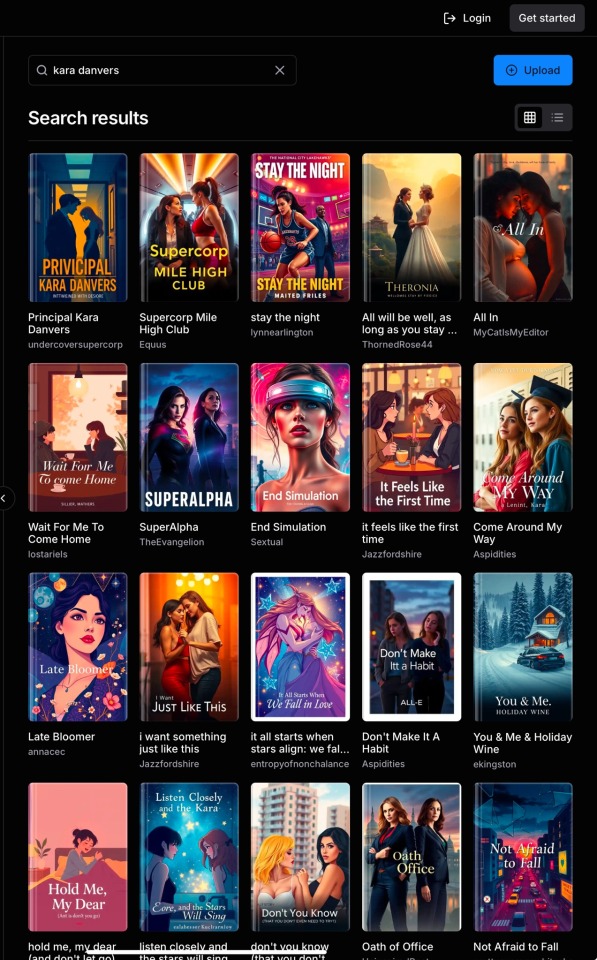
I went looking online for any mention of word-stream and AI plagiarism (the covers—as well as the ridiculously inflated number of reviews and ratings—made it immediately obvious that AI fuckery was involved), but found almost nothing: only one single Reddit post had been made, and it received (at that time) only a handful of upvotes and no advice.
I decided to make a tumblr post to bring the supercorp fandom up to speed about the theft. I draw as well as write for fandom and I’ve only ever had to deal with art theft—which has a clear set of steps to take depending on where said art was reposted—and I was at a loss regarding where to start in this situation.
After my post went up I remembered Project Copy Knight, which is worth commending for the work they’ve done to get fic stolen from AO3 taken down from monetized AI 'audiobook’ YouTube accounts. I reached out to @echoekhi, asking if they’d heard of this site and whether they could advise me on how to get our works taken down.

While waiting for a reply I looked into Copy Knight’s methods and decided to contact OTW’s legal department:
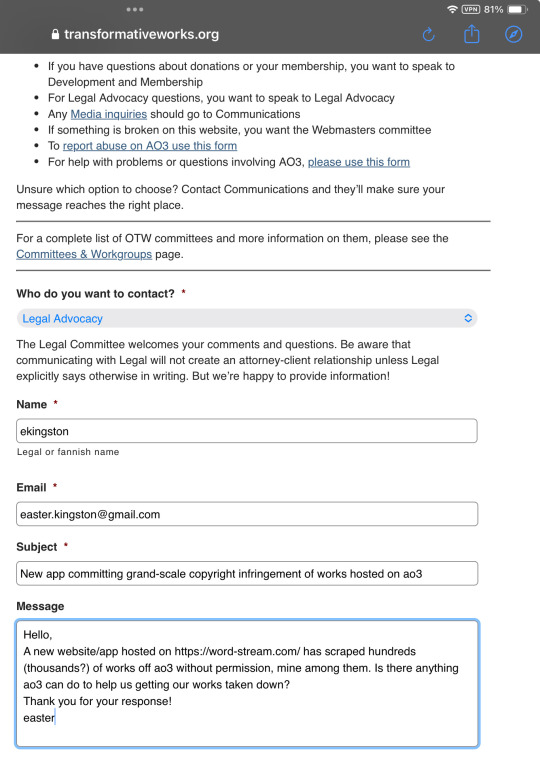
And then I went to bed.
By morning, tumblr friends @makicarn and @fazedlight as well as a very helpful tumblr anon had seen my post and done some very productive sleuthing:

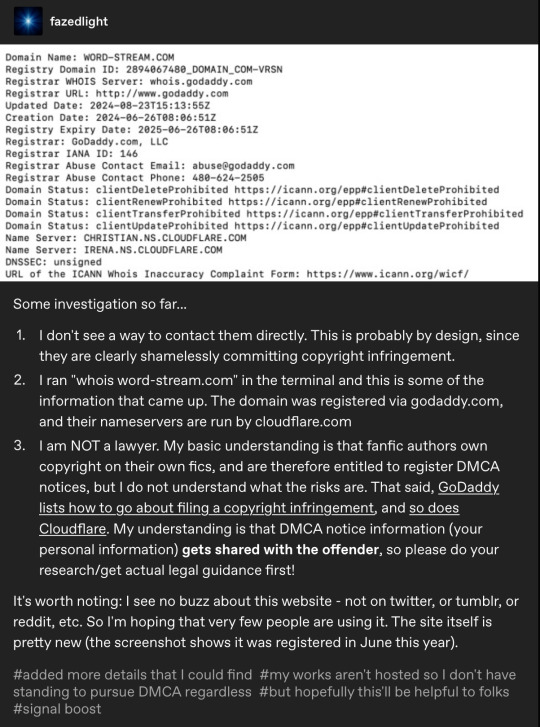
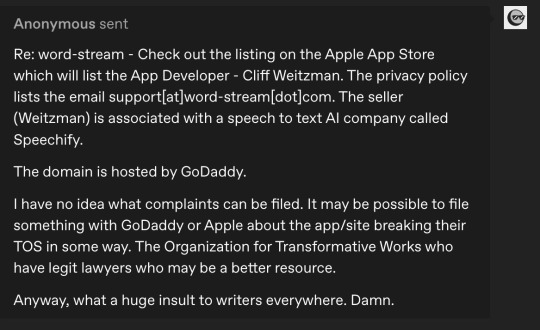
@echoekhi had also gotten back to me, advising me, as expected, to contact the OTW. So I decided to sit tight until I got a response from them.
That response came only an hour or so later:
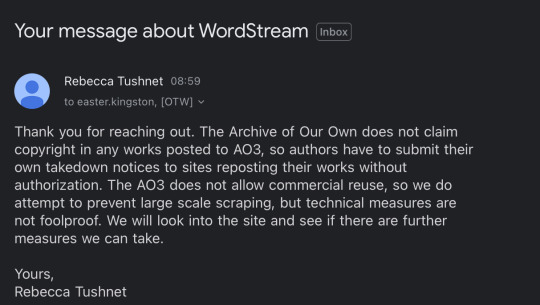
Which was 100% understandable, but still disappointing—I doubted a handful of individual takedown requests would accomplish much, and I wasn’t eager to share my given name and personal information with Cliff Weitzman himself, which is unavoidable if you want to file a DMCA.
I decided to take it to Reddit, hoping it would gain traction in the wider fanfic community, considering so many fandoms were affected. My Reddit posts (with the updates at the bottom as they were emerging) can be found here and here.
A helpful Reddit user posted a guide on how users could go about filing a DMCA against word-stream here (to wobbly-at-best results)
A different helpful Reddit user signed up to access insight into word-streams pricing. Comment is here.
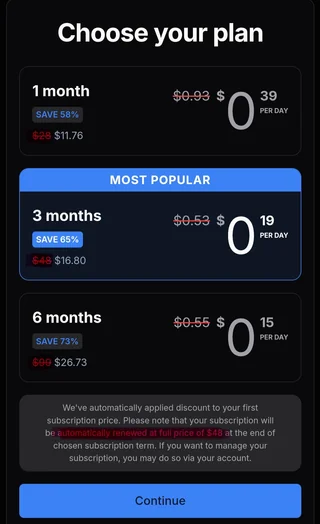
Smells unbelievably scammy, right? In addition to those audacious prices—though in all fairness any amount of money would be audacious considering every work listed is accessible elsewhere for free—my dyscalculia is screaming silently at the sight of that completely unnecessary amount of intentionally obscured numbers.
Speaking of which! As soon as the post on r/AO3—and, as a result, my original tumblr post—began taking off properly, sometime around 1 pm, jumpscare! A notification that a tumblr account named @cliffweitzman had commented on my post, and I got a bit mad about the gist of his message :
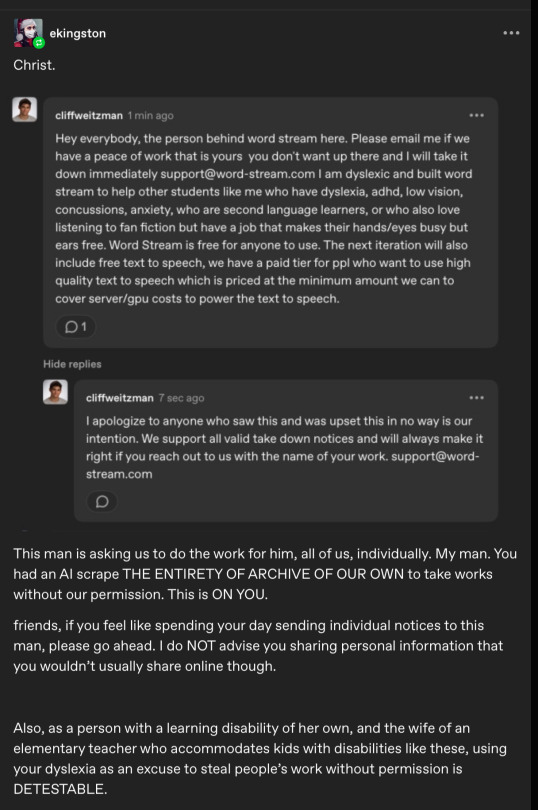
Fortunately he caught plenty of flack in the comments from other users (truly you should check out the comment section, it is extremely gratifying and people are making tremendously good points), in response to which, of course, he first tried to both reiterate and renegotiate his point in a second, longer comment (which I didn’t screenshot in time so I’m sorry for the crappy notification email formatting):

which he then proceeded to also post to Reddit (this is another Reddit user’s screenshot, I didn’t see it at all, the notifications were moving too fast for me to follow by then)
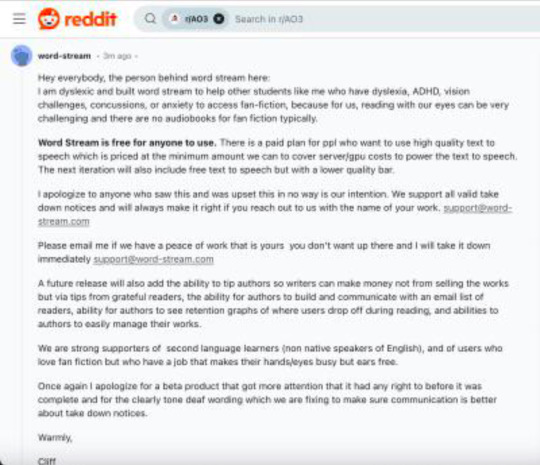
... where he got a roughly equal amount of righteously furious replies. (Check downthread, they're still there, all the way at the bottom.)
After which Cliff went ahead & deleted his messages altogether.
It’s not entirely clear whether his account was suspended by Reddit soon after or whether he deleted it himself, but considering his tumblr account is still intact, I assume it’s the former. He made a handful of sock puppet accounts to play around with for a while, both on Reddit and Tumblr, only one of which I have a screenshot of, but since they all say roughly the same thing, you’re not missing much:

And then word-stream started throwing a DNS error.
That lasted for a good number of hours, which was unfortunately right around the time that a lot of authors first heard about the situation and started asking me individually how to find out whether their work was stolen too. I do not have that information and I am unclear on the perimeters Weitzman set for his AI scraper, so this is all conjecture: it LOOKS like the fics that were lifted had three things in common:
They were completed works;
They had over several thousand kudos on AO3; and
They were written by authors who had actively posted or updated work over the past year.
If anyone knows more about these perimeters or has info that counters my observation, please let me know!
I finally thought to check/alert evil Twitter during this time, and found out that the news was doing the rounds there already. I made a quick thread summarizing everything that had happened just in case. You can find it here.
I went to Bluesky too, where fandom was doing all the heavy lifting for me already, so I just reskeeted, as you do, and carried on.
Sometime in the very early evening, word-stream went back up—but the fan fiction category was nowhere to be seen. Tentative joy and celebration!***
That’s when several users—the ones who had signed up for accounts to gain intel and had accessed their own fics that way—reported that their work could still be accessed through their history. Relevant Reddit post here.
Sooo—
We’re obviously not done. The fanwork that was stolen by Weitzman may be inaccessible through his website right now, but they aren’t actually gone. And the fact that Weitzman wasn’t willing to get rid of them altogether means he still has plans for them.
This was my final edit on my Reddit post before turning off notifications, and it's pretty much where my head will be at for at least the foreseeable future:
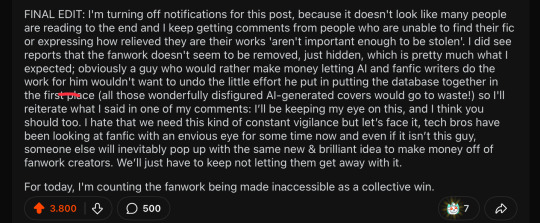
Please feel free to add info in the comments, make your own posts, take whatever action you want to take to protect your work. I only beg you—seriously, I’m on my knees here—to not give up like I saw a handful of people express the urge to do. Keep sharing your creative work and remain vigilant and stay active to make sure we can continue to do so freely. Visit your favorite fics, and the ones you’ve kept in your ‘marked for later’ lists but never made time to read, and leave kudos, leave comments, support your fandom creatives, celebrate podficcers and support AO3. We created this place and it’s our responsibility to keep it alive and thriving for as long as we possibly can.
Also FUCK generative AI. It has NO place in fandom spaces.
THE 'SMALL' PRINT (some of it in all caps):
*Weitzman knew what he was doing and can NOT claim ignorance. One, it’s pretty basic kindergarten stuff that you don’t steal some other kid’s art project and present it as your own only to act surprised when they protest and then tell the victim that they should have told you sooner that they didn’t want their project stolen. And two, he was very careful never to list the IPs these fanworks were based on, so it’s clear he was at least familiar enough with the legalities to not get himself in hot water with corporate lawyers. Fucking over fans, though, he figured he could get away with that.
**A note about the AI that Weitzman used to steal our work: it’s even greasier than it looks at first glance. It’s not just the method he used to lift works off AO3 and then regurgitate onto his own website and app. Looking beyond the untold horrors of his AI-generated cover ‘art’, in many cases these covers attempt to depict something from the fics in question that can’t be gleaned from their summaries alone. In addition, my fics (and I assume the others, as well) were listed with generated genres; tags that did not appear anywhere in or on my fic on AO3 and were sometimes scarily accurate and sometimes way off the mark. I remember You & Me & Holiday Wine had ‘found family’ (100% correct, but not tagged by me as such) and I believe The Shape of Soup was listed as, among others, ‘enemies to friends to lovers’ and ‘love triangle’ (both wildly inaccurate). Even worse, not all the fic listed (as authors on Reddit pointed out) came with their original summaries at all. Often the entire summary was AI-generated. All of these things make it very clear that it was an all-encompassing scrape—not only were our fics stolen, they were also fed word-for-word into the AI Weitzman used and then analyzed to suit Weitzman’s needs. This means our work was literally fed to this AI to basically do with whatever its other users want, including (one assumes) text generation.
***Fan fiction appears to have been made (largely) inaccessible on word-stream at this time, but I’m hearing from several authors that their original, independently published work, which is listed at places like Kindle Unlimited, DOES still appear in word-stream’s search engine. This obviously hurts writers, especially independent ones, who depend on these works for income and, as a rule, don’t have a huge budget or a legal team with oceans of time to fight these battles for them. If you consider yourself an author in the broader sense, beyond merely existing online as a fandom author, beyond concerns that your own work is immediately at risk, DO NOT STOP MAKING NOISE ABOUT THIS.
PLEASE check my later versions of this post via my main page to make sure you have the latest version of this post before you reblog. All the information I’ve been able to gather is in my reblogs below, and it's frustrating to see the old version getting passed around, sending people on wild goose chases.
Thank you all so much!
#fandom culture#fanfic culture#ao3 culture#ai in fandom#described#image description#described by me(at)
48K notes
·
View notes
Text
Unlock Your Coding Potential: Mastering Python, Pandas, and NumPy for Absolute Beginners
Ever thought learning programming was out of your reach? You're not alone. Many beginners feel overwhelmed when they first dive into the world of code. But here's the good news — Python, along with powerful tools like Pandas and NumPy, makes it easier than ever to start your coding journey. And yes, you can go from zero to confident coder without a tech degree or prior experience.
Let’s explore why Python is the best first language to learn, how Pandas and NumPy turn you into a data powerhouse, and how you can get started right now — even if you’ve never written a single line of code.
Why Python is the Ideal First Language for Beginners
Python is known as the "beginner's language" for a reason. Its syntax is simple, readable, and intuitive — much closer to plain English than other programming languages.
Whether you're hoping to build apps, automate your work, analyze data, or explore machine learning, Python is the gateway to all of it. It powers Netflix’s recommendation engine, supports NASA's simulations, and helps small businesses automate daily tasks.
Still unsure if it’s the right pick? Here’s what makes Python a no-brainer:
Simple to learn, yet powerful
Used by professionals across industries
Backed by a massive, helpful community
Endless resources and tools to learn from
And when you combine Python with NumPy and Pandas, you unlock the true magic of data analysis and manipulation.
The Power of Pandas and NumPy in Data Science
Let’s break it down.
🔹 What is NumPy?
NumPy (short for “Numerical Python”) is a powerful library that makes mathematical and statistical operations lightning-fast and incredibly efficient.
Instead of using basic Python lists, NumPy provides arrays that are more compact, faster, and capable of performing complex operations in just a few lines of code.
Use cases:
Handling large datasets
Performing matrix operations
Running statistical analysis
Working with machine learning algorithms
🔹 What is Pandas?
If NumPy is the engine, Pandas is the dashboard. Built on top of NumPy, Pandas provides dataframes — 2D tables that look and feel like Excel spreadsheets but offer the power of code.
With Pandas, you can:
Load data from CSV, Excel, SQL, or JSON
Filter, sort, and group your data
Handle missing or duplicate data
Perform data cleaning and transformation
Together, Pandas and NumPy give you superpowers to manage, analyze, and visualize data in ways that are impossible with Excel alone.
The Beginner’s Journey: Where to Start?
You might be wondering — “This sounds amazing, but how do I actually learn all this?”
That’s where the Mastering Python, Pandas, NumPy for Absolute Beginners course comes in. This beginner-friendly course is designed specifically for non-techies and walks you through everything you need to know — from setting up Python to using Pandas like a pro.
No prior coding experience? Perfect. That’s exactly who this course is for.
You’ll learn:
The fundamentals of Python: variables, loops, functions
How to use NumPy for array operations
Real-world data cleaning and analysis using Pandas
Building your first data project step-by-step
And because it’s self-paced and online, you can learn anytime, anywhere.
Real-World Examples: How These Tools Are Used Every Day
Learning Python, Pandas, and NumPy isn’t just for aspiring data scientists. These tools are used across dozens of industries:
1. Marketing
Automate reports, analyze customer trends, and predict buying behavior using Pandas.
2. Finance
Calculate risk models, analyze stock data, and create forecasting models with NumPy.
3. Healthcare
Track patient data, visualize health trends, and conduct research analysis.
4. Education
Analyze student performance, automate grading, and track course engagement.
5. Freelancing/Side Projects
Scrape data from websites, clean it up, and turn it into insights — all with Python.
Whether you want to work for a company or freelance on your own terms, these skills give you a serious edge.
Learning at Your Own Pace — Without Overwhelm
One of the main reasons beginners give up on coding is because traditional resources jump into complex topics too fast.
But the Mastering Python, Pandas, NumPy for Absolute Beginners course is designed to be different. It focuses on real clarity and hands-on practice — no fluff, no overwhelming jargon.
What you get:
Short, focused video lessons
Real-world datasets to play with
Assignments and quizzes to test your knowledge
Certificate of completion
It’s like having a patient mentor guiding you every step of the way.
Here’s What You’ll Learn Inside the Course
Let’s break it down:
✅ Python Essentials
Understanding variables, data types, and functions
Writing conditional logic and loops
Working with files and exceptions
✅ Mastering NumPy
Creating and manipulating arrays
Broadcasting and vectorization
Math and statistical operations
✅ Data Analysis with Pandas
Reading and writing data from various formats
Cleaning and transforming messy data
Grouping, aggregating, and pivoting data
Visualizing insights using built-in methods
By the end, you won’t just “know Python” — you’ll be able to do things with it. Solve problems, build projects, and impress employers.
Why This Skillset Is So In-Demand Right Now
Python is the most popular programming language in the world right now — and for good reason. Tech giants like Google, Netflix, Facebook, and NASA use it every day.
But here’s what most people miss: It’s not just about tech jobs. Knowing how to manipulate and understand data is now a core skill across marketing, operations, HR, journalism, and more.
According to LinkedIn and Glassdoor:
Python is one of the most in-demand skills in 2025
Data analysis is now required in 70% of digital roles
Entry-level Python developers earn an average of $65,000 to $85,000/year
When you combine Python with Pandas and NumPy, you make yourself irresistible to hiring managers and clients.
What Students Are Saying
People just like you have used this course to kickstart their tech careers, land internships, or even launch freelance businesses.
Here’s what learners love about it:
“The lessons were beginner-friendly and not overwhelming.”
“The Pandas section helped me automate weekly reports at my job!”
“I didn’t believe I could learn coding, but this course proved me wrong.”
What You’ll Be Able to Do After the Course
By the time you complete Mastering Python, Pandas, NumPy for Absolute Beginners, you’ll be able to:
Analyze data using Pandas and Python
Perform advanced calculations using NumPy arrays
Clean, organize, and visualize messy datasets
Build mini-projects that show your skills
Apply for jobs or gigs with confidence
It’s not about becoming a “coder.” It’s about using the power of Python to make your life easier, your work smarter, and your skills future-proof.
Final Thoughts: This Is Your Gateway to the Future
Everyone starts somewhere.
And if you’re someone who has always felt curious about tech but unsure where to begin — this is your sign.
Python, Pandas, and NumPy aren’t just tools — they’re your entry ticket to a smarter career, side income, and creative freedom.
Ready to get started?
👉 Click here to dive into Mastering Python, Pandas, NumPy for Absolute Beginners and take your first step into the coding world. You’ll be amazed at what you can build.
0 notes
Text
The Many Applications of Residential Proxy Servers
Residential proxy servers are a powerful tool that can enable a wide variety of use cases across different industries. Unlike datacenter proxies that use IP addresses assigned to servers, residential proxies leverage IP addresses belonging to real internet users and their home devices. This provides several key advantages that make residential proxies invaluable for many applications.
Web Scraping and Data Extraction
One of the primary use cases for residential proxies is web scraping and large-scale data extraction. When scraping websites, using residential IPs can significantly reduce the chances of getting blocked or banned. Websites are much more likely to trust and allow requests coming from residential IP addresses versus those from known data centerIP ranges.
This makes residential proxies essential for price comparison, market research, lead generation, and competitive analysis. A market researcher, for example, can use residential proxies to gather sales intelligence data from various e-commerce sites without revealing their actual location or IP address.
Similarly, an e-commerce business can leverage residential IPs to monitor product listings, prices, and reviews across competitor websites. This provides valuable insights to inform their own pricing and product strategies.
Content Access and Geo-Targeting
Residential proxies also enable users to access online content that is restricted or only available in certain geographic regions. This is particularly useful for streaming services like Netflix, Hulu, or BBC iPlayer, which often impose geo-restrictions on their content libraries.
By connecting through a residential proxy in the target location, users can bypass these restrictions and access the local content catalog. This is valuable not just for individual consumers, but also for businesses that need to test their apps and websites from different locations.
Residential proxies can also help businesses deliver more personalized, location-based experiences to their customers. An e-commerce store, for instance, can use residential IPs to show users products, pricing, and promotions tailored to their apparent geographic region.
Ad Verification and Brand Protection
Residential proxy networks are crucial for verifying the delivery and performance of online advertising campaigns. Ad verification providers can use residential IPs to monitor the visibility, placement, and engagement of ads across various websites, apps, and platforms without being detected or blocked.
This helps identify ad fraud, such as bot traffic or competitor interference and ensures brands get the full value from their advertising spend. Residential proxies are also vital for brand protection use cases, where businesses need to constantly monitor the web for copyright infringement, trademark abuse, and other malicious activities.
Application and Website Testing
Residential proxy servers play a key role in testing the functionality, usability, and performance of apps and websites across different locations, devices, and network conditions. Developers and QA teams can use residential IPs to simulate real-world user experiences from various geographic regions.

Fintech and Financial Services
In the financial sector, residential proxies are used for a range of applications, from fraud detection to market data aggregation. Banks and fintech firms can leverage residential IPs to monitor online transactions, identify suspicious activities, and prevent financial crimes like money laundering.
Residential proxies are also crucial for collecting real-time market data, such as stock prices and currency exchange rates, from various sources without being blocked or rate-limited. This data can then be used to power trading algorithms, investment research, and other financial services.
Residential Proxy Advantages
The key advantages that make residential proxies so valuable across these diverse use cases include:
Increased Trust and Reduced Blocking: Websites and online services are generally more trusting of requests from residential IP addresses, as they are less likely to be associated with bots, scrapers, or other malicious activities. This significantly reduces the chances of getting blocked or banned.
Improved Geo-Targeting: Residential proxies allow users to appear as if they are accessing the internet from different geographic locations, enabling more accurate location-based content, pricing, and experiences.
Enhanced Privacy and Anonymity: By masking the user’s actual IP address and location, residential proxies provide an extra layer of privacy and anonymity, which is crucial for sensitive applications like financial services and brand protection.
Scalability and Reliability: Residential proxy networks, such as those offered by providers like NetNut, can offer unlimited concurrent sessions and high availability, ensuring consistent performance and reliability even under heavy load.
0 notes
Text
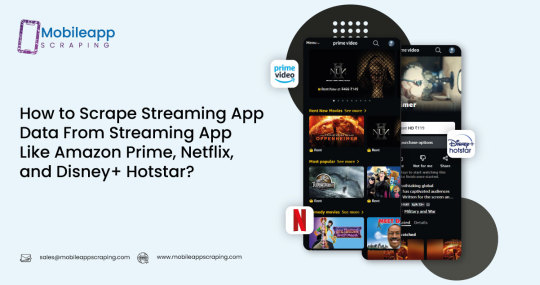
Scrape Streaming App Data | Amazon Prime | Netflix | Disney+ Hotstar
know me>> https://www.mobileappscraping.com/scrape-streaming-app-data-from-amazon-prime-netflix-disney-plus-hotstar.php
#ScrapeStreamingAppsData#ExtractStreamingAppsData#StreamingAppsDataScraping#StreamingAppsDataCollection
0 notes
Text
Scrape OTT Media Platform App Data | Streaming App Data Scraping
Mobile App Scraping offers OTT Media Platform Data Scraping Services to extract data from popular OTT Media Platforms such as Netflix, Amazon Prime Video, Hulu, and Disney+ Hotstar and more.
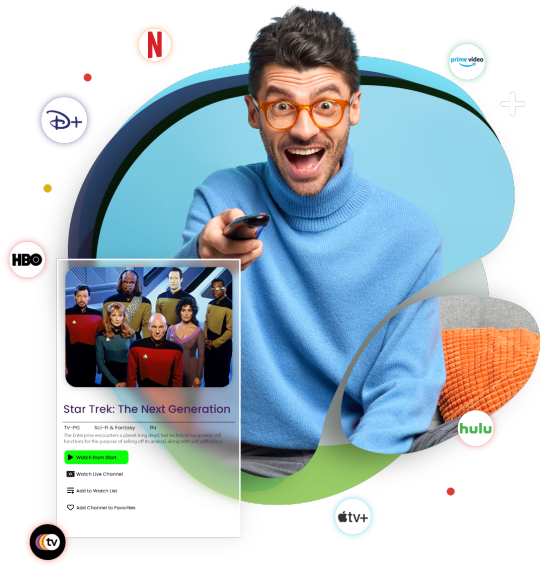
#Scrape OTT Media App Data#Streaming App Data Scraping#Scrape Streaming App Data#OTT Media Platform App Data Scraping
0 notes
Text
The State of Technology Today
In old science fiction, they described the Internet (even before the Internet was invented) as a landscape you would plug into and get a rush from - my favorite book on the subject is Neuromancer. Maybe you’d plug something into your brain, and then there would be so much information that you would get high on it.
The Internet now is really not that far off from the science fiction fantasy, it’s just more integrated with reality. You go on the phone while waiting for the bus, and you’re there. You record something happening now onto your Facebook live, and you’re there. It’s not quite so interesting to talk about cyberspace as a literal space because we don’t fade to black and transfer our consciousness to the net, like we would in this fantasy, but in a sense the brain does similar things. Inside the net, our minds go into a different mode of thinking. We quickly open links, instead of linearly processing information like we would while reading a book. We see things differently...people become a front-facing entity we can interact with, and a backend we don’t see.
I wish I could refer to this imaginary cyber universe as The Matrix, but unfortunately someone already copyrighted that term. I’m just going to keep calling it FIGNATIA (Facebook, Instagram, Google, Netflix, Apple, TikTok, Intel, Amazon) until it catches on. Even when it doesn’t, I’m going to keep calling it that.
FIGNATIA is the world we enter when we turn on anything that gets us into the net. FIGNATIA is accessible on a phone, a laptop, even a Kindle. And FIGNATIA, in this day and age, is where most of us choose to spend most of our waking moments.
Is it bad? I don’t think so, but there’s certainly something a little bit terrifying about it. In this imagined world, we have a separate entity that’s like us, but not us. It’s a series of attributes, the presence we create every time we like, share, write, or post something. We’re creating a persona for ourselves, and even when we project it via a conference video or a picture, it’s still not REALLY us. It’s as authentic as we can make it, but it’s still just far enough from real to serve as something of a mockup.
View Facebook in developer mode, and you can see the JSON-like attribute structure that makes up every person. Hit “view source” on a website, and you can see portions of the frontend code that render a website. Unless you’re an app developer or a data scientist, you’re not going to get much out of this except the ability to to remember passwords you forgot and bypass certain payment walls (or, in my case, briefly pretend I’m Neo in The Matrix)...but as a metaphor, I find it interesting.
Many of these things, like software objects or whatever the f*** it is JavaScript decided to use, have an outward-facing component. That’s our world - it’s an image that makes comments, a username we talk to, a bunch of pictures. Underneath that, in the background, are all the many pieces of related information that develop as we go about our lives in FIGNITIA. They have metadata. They don’t just track what we post, they track the locations, the times, the many other related pieces of data. With this information at their disposal, FIGNITIA attempts to predict the future by influencing it - it determines what we’re likely to want next, how long we want it for, where we’re going.
And someone like me will act like we’re above all this by seemingly making nothing secret, and by sharing thoughts like this with the world...security by obfuscation, we might say...no one can find anything on me if they have to navigate through a deluge. But then tracking tools exist. Run Tumblr through some tools that leverage the API, and you can tease out specific details. In the same way, websites that cannot seem to be shut down exist that scrape addresses, simply by using associated information.
I think. I never figured out how some of these tools work, and why they’re legal.
FIGNITIA exists in a feedback loop. We compete for approval, for attention, and the data this provides is enough to make a person feel high. Briefly. The amount of pleasure created is so brief, and so fleeting, that we keep finding ourselves drawn back.
And, again...nothing is wrong with this. But it’s not reality. What I write here is still coming from me, but it’s not EXACTLY the cadence of how I interact in real life. The picture I post may be as close a representation of reality as modern technology can create, but it’s still not QUITE real. Recording serves as a way to document history, but at what point do we record excessively? At what point do we find ourselves traveling to landmarks for the pictures, instead of to behold the view?
Reality, in that sense, can quickly feel more like a recording effort than like a series of experiences to enjoy, or at least to live through. The problem with this virtual reality isn’t that it’s bad or overly addictive, but that it seems so close to reality that the two images become immistable.
We all have the ability to unplug, at any moment we want to, and that’s why there’s nothing inherently bad about the software world we have created. It marks people safe in natural disasters, creates no shortage of minable data we can exploit in order to determine trends, allows us to investigate things in ways most people don’t even know are possible by combing data they don’t even remember creating. The net is beautiful, in that sense - for advertising, for helping to make business transactions, for forming a brand on the skills in our respective fields we wish to market. The net is great. I cannot even remember what life was like before we had a high-speed connection.
But it seems we live so many times in it, from the latest TV series to the newest news article to the last thing suggested to us by an algorithm passively harvesting the information we provided. And sometimes it feels wrong, but I don’t know why. There’s no patience in it. In the net, time passes differently.
1 note
·
View note
Text
Somatic Evolution And International Expansion Of An Ancient Transmissible Cancer Lineage
Lineage features 2D isometric-overhead graphics similar to those of Ultima Online and Diablo II Lineage II: The Chaotic Chronicle , a "prequel" set 150 years before the time of Lineage, was released in 2003. Regrettably no, like LineageOS it still has some non-free of charge components. Hawaiian residence-cooking makes up the menus at Lineage, exactly where nearby chef Sheldon Simeon dishes up fuss-free, completely imperfect plates of garlicky fried noodles, poke bowls, ginger chicken and much more. Please share your experience by adding your comments beneath and stay tuned for much more on information lineage at Netflix in the follow up blog posts.

Instead, the group has moved on to Lineage OS 16. (based on Android 9. Pie ). Lineage's menu draws inspiration from Simeon's background growing up in Hawaii and his Filipino ancestry. Not every device supports the same Lineage OS version, even if the devices come from the same 리니지프리서버 manufacturer. In the rest of this blog, we will a) touch on the complexity of Netflix cloud landscape, b) discuss lineage style ambitions, ingestion architecture and the corresponding information model, c) share the challenges we faced and the learnings we picked up along the way, and d) close it out with what is next" on this journe />There was also a period of time where Short Form Applications" had been accepted with only a few listed generations as an alternative of the full lineage from the applicant to the patriot. The purpose of the Descendants Database is to support those looking for a DAR Patriot or lineage to determine how a lot of their lineage has currently been proven and to determine the ideal achievable Record Copy to orde />Replace the LineageOS official keys in our migration ZIP with your keys (or follow the recommendations in the LineageOS migration guide ). Sheldon Simeon of Lineage and Tin Roof on Maui takes foraged hapu‘u, a hairy Hawaiian tree fern that towers at seven feet tall, and soaks it in water for a day, then boils, scrapes and boils it once again prior to turning it into an earthy st />Consequently, creating a complete and accurate information lineage method to map out all the data-artifacts (including in-motion and at-rest information repositories, Kafka topics, apps, reports and dashboards, interactive and ad-hoc analysis queries, ML and experimentation models) is a monumental job and needs a scalable architecture, robust design, a strong engineering team and above all, incredible cross-functional collaboration.
1 note
·
View note
Text
S7 data cronch pt2: get the hot dogs, the fandom’s on fire
Before I jump into the more tangled datasets, there’s something interesting I want to call out, and that’s the vlogs.
In September of last year, DW released vlogs for Coran, Keith, and Allura. A month later, we got vlogs for Lance, Pidge, and Hunk. Shiro’s vlog finally arrived on June, this year. That final vlog now shows a July date, but when it was first discovered, its posting date was 6/28. (I have no idea why it was changed. Ask @ptw30.)
In the first part, I mentioned audience engagement. The vlogs are a good object lesson. If we take the number of views divided by the number of days since posting, we get an idea of the daily ‘value’ of each vlog.
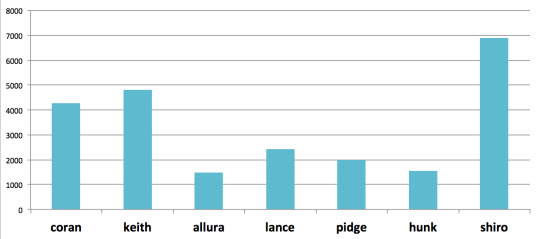
Shiro clocks in at 6877 views per day, while the next closest, Keith, has 4796 per day. Hey, so maybe that’s just everyone excited after waiting almost a year.
So, how about this graph?
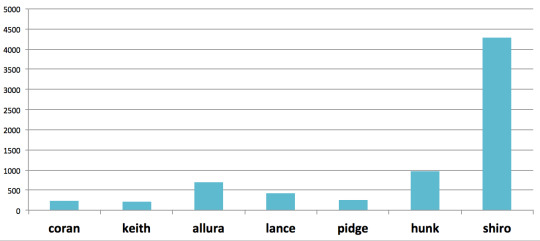
Shiro has 4,293 comments. The next closest are Allura and Hunk, with 692 and 976, respectively. All told, Shiro got 1.5 times as many comments as all the rest of the characters together. Now that is audience engagement.
Alright, now that you’ve got a bit of data on which character clearly gets the fandom engaged and talking, let’s see what else we can learn about S7.
Hop to, behind the cut.
so about that twitter debacle
There’s no way to fully illustrate just how incomprehensibly bonkers twitter was for awhile. I know there’s a toxic side to the fandom that weaponizes twitter, but... in general, the VLD fandom isn’t noisy, compared to other fandoms. Daily counts range from 30-100 tweets. That makes it harder to tell when things go dead quiet, but it sure makes it easy to tell when things explode.
So let’s go back to the Sunday after S7 landed. For this season, I included sentiment analysis. At first I searched on #voltron, then I realized one of the trackers lets me go by keywords, so I did a comparative search on ‘voltron’. Hashtag use seemed to be for being seen by others, while keyword seemed to be more for conversation, reassurance, and reflection.
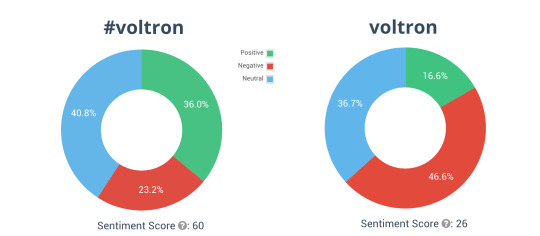
That’s... pretty strong, for both. And I honestly had never seen a twitter stream get a sentiment analysis as negative as the one on the right. After working my way through 11,889 tweets (from Aug 10th to the 25th), I can tell you one thing for certain.
Everyone was angry about something.
One group, predictably, was angry at being denied their long-awaited affirmation. A second was furious at the queerbaiting; that group overlapped with a third enraged at the Bury Your Gays trope. A fourth dismissed the BYG trope yet were angry at the lack of explicit relationship beyond a single break-up scene; that caused a few flare-ups between the 3rd and 4th groups for the latter treating Shiro as queer purely on his facebook status. A fifth group (oddly, calmer voices, for the most part) was upset at VLD’s treatment of Shiro in general, from his isolation to his tokenization.
On the other end of the spectrum, the majority of positives loved the season but were angry that others didn’t or wouldn’t. A much smaller percentage took their own shots: insisting children don’t need LGBT+ rep, calling LGBT+ fans entitled, telling DW not to pander, or complaining DW/Netflix had mixed politics and entertainment. (There’s an answer to the last one, but that’s for another post.)
I believe the technical term for Aug 10th-25th would be clusterfuck.
going deeper for context
Getting a clearer picture than the donut chart meant considering the context. In other words, for every seemingly-neutral tweet, I’d open the feed, and majority of the time I found threads voicing bitter disappointment, frustration, and hurt. These deeper threads almost never tagged anyone, and they tended to be more nuanced, compared to upper-level mentions loaded with easily-classed negative or positive keywords.
Here’s a snapshot of the twitter stream on August 10th, which includes metrics for those deeper contextual threads.
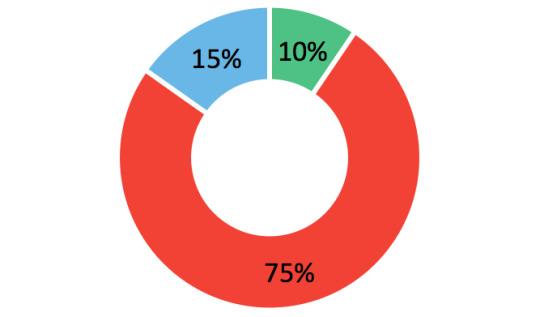
There’s just no way to spin that much of a backlash. By the end of the first day of release, the signs were already there that --- at least as far as the majority of the internet-based fandom was concerned --- S7 was an unmitigated disaster.
it’s just twitter, no one’s paying attention
That sounds like something a Boomer-aged exec might say. They’d also be wrong (not to mention ignorant).
Note: I used two different analysis apps. Both were rather blunt-force, rating “S7 wasn’t half bad” or “brutal but what I wanted” as negative, while "go to hell, I loved VLD but not anymore" was rated positive. One of the two apps let me re-evaluate, but it only allowed for negative-neutral-positive. (Lesson learned: set up a twitter scrape ahead of time, so I can run it all against a good AI.)
For this part, I used the second tracker and manually evaluated the values for ‘voltron’ mentions. Unfortunately, I had to rely on the tracker’s value for most non-English tweets. I designated ‘positive’ for explicitly pro-S7, and ‘negative’ explicitly con-S7. For any mentions that were ambiguous, incoherent, or personally-directed, I defaulted to neutral. My goal was to measure who was or wasn’t happy with the season itself, and not attacks on or support for the staff, DW, Netflix, or other people in the fandom.
With that madness done, here’s the entirety of August.

On the day of release, a total of 1853 mentions created a social media reach of 1.46 million. My next question was: is this low-influencer unhappiness vs high-influencer happiness, vice versa, or something else? This next chart is the data filtered down to influencers with a score of 7 or above (based on followers, retweets, and replies).

That’s 78 negative mentions, 16 positive, and the remainder neutral. All told, 194 mentions had a social media reach of 1.36 million. That’s a lot considering the voltron keyword usually has a social media reach of 50K, tops.
This was a groundswell reaction. The reach was driven by big voices, but the bulk were individuals unhappy for any of a variety of reasons. Any apology --- after four days of fever pitch --- was going to have an uphill fight to calm the crowd, no matter how gracefully it was written.
On the 14th -- when news outlets began reacting to JDS’ apology -- we got a second spike. 1573 mentions with a social media reach of 1.3 million; the new megaphones in the stream were news outlets promoting articles. (Also, most of their tweets are strongly click-bait in tone, compared to the actual article titles.)
If you googled ‘voltron legendary defender’ on the 14th, you got these results:
Voltron Showrunner Apologizes to Fans Following Outrage over Gay Character’s Storyline [Syfy Wire]
Voltron Showrunner Pens Open Apology Letter [The Mary Sue]
Voltron Showrunner Apologizes for Series' Handling of Gay Relationship {CBR}
Voltron's Complicated, Imperfect LGBQT Representation Is Tearing the Fandom Apart [In-Depth-Gizmodo]
Joaquim Dos Santos Shares Letter About Voltron Queer Representation [The Geekiary]
The ‘Voltron’ Showrunner Apologized For Making a Mess of the Show’s Gay Representation [Hornet]
Of course, Josh Keaton got sent out to calm the anger, too.
'Voltron' Star Josh Keaton On Season 7, Shiro's Sexuality, and How a Leader Grieves [Comicbook.com]
Shiro Voice Actor Responds to 'Voltron' Season 7 Controversy [Inverse]
Exclusive: Josh Keaton talks 'Voltron' season 7, Shiro's new arc, love and loss [Hypable]
You had to scroll past all that before you could get to anything remotely like a positive news item (and nowhere near the usual post-release deluge of compliments to the creators).
On Aug 15th, more articles:
Voltron: Legendary Defender’s Showrunner Offers a Genuine Apology to the Fandom [Gizmodo]
Voltron's Complicated, Imperfect LGBQT Representation Is Tearing The Fandom Apart [Kotaku Australia] (reprint)
Either these were latecomers, or DW was pulling out all the stops to hit every possible venue. Didn’t matter; the furor wasn’t dying down. Josh wasn’t sent out again, either. DW may’ve realized that ship had sailed (so to speak).
On Aug 16th, these articles appeared:
Voltron creator addresses fans over season 7's queerbaiting controversy [Polygon]
How “Voltron: Legendary Defender” Queerbaited Its Fans [NewNowNext]
Voltron showrunner apologises to fans after backlash over treatment of gay character [DigitalSpy]
Voltron: Legendary Defender showrunner apologises to fans after killing off gay character [PinkNews]
Why 'Voltron' fans are furious after season 7 [The Daily Dot]
Voltron Showrunner Apologizes for Season 7's Treatment of Gay Couple [ScreenRant]
'Voltron' Shiro: Stop Preemptively Outing Gay Characters To Generate Buzz [Inverse]
And it kept going through Aug 17, 2018.
Voltron: Legendary Defender Showrunner Joaquim Dos Santos Apologizes For Alleged Queer-bating Of Fans Over Handling Of Shiro’s Sexual Orientation [Inside Pulse]
Who's Sorry This Week? Lindsay Lohan, Sarah Huckabee Sanders and other public apologies [Mic]
Meanwhile, as of the 18th, the predictive algorithm for #voltron (the actual hashtag) was estimating +6% for the upcoming week, and +6% for the month. Not even half what S6 had in its first week after broadcast, but remember, the majority of S7′s traffic wasn’t happening on the hashtag. It was happening in mentions.
You might think from the above that things quieted by the 19th. You’d be wrong. It’s still going on. Keep in mind these pie charts are cumulative by month. On the left are the totals through the morning of Aug 22; on the right, the totals through the afternoon of Aug 25.
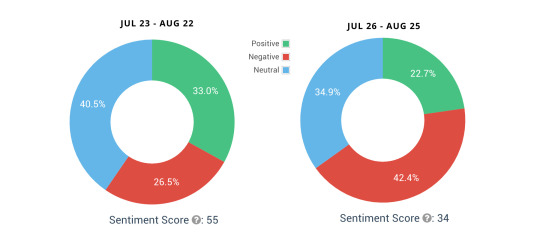
Midday on the 22nd, we had another spike, one large enough to offset that these are monthly totals, not daily. (The most likely culprit is the DW marketing gif that showed the scene where Adam dies, thus kicking the hornet’s nest all over again.)
As we entered the third week, the predictive algorithm for #voltron dropped to -1% for the month, and -5% for the week; for #vld, it’s -2% for the month and -6% for the week.
In fact, almost every related hashtag is predicted to drop in popularity and use over the next week or beyond. That includes:
voltronlegendarydefender, -2%
keithkogane, -8%
keith, -3%
shiro, -9%
lance, -6%
lancemcclain, -1%
takashishirogane, -20%
allura, -5%
princessallura, -10%
hunkgarrett, -6%
lotor, -4%
katieholt, -5%
Even ship names:
klance, -2%
shadam, -8%
adashi, -3%
plance, -2%
pidgance, -5%
sheith, -2%
lotura, -10%
kallura, -1%
The exceptions? allurance (4%) and pidge (1%).
It took a bombshell EP interview to knock S6 off its upward rise. This time around, the fall looks more like people tiring of the fight and checking out.
one more part coming
Thanks to the additional manipulations I did on twitter this season, this section took more words (and I cut it down from walking you through every agonizing step, no need to thank me for sparing you). I’ve also added a new dataset, and that pushed the total word count beyond even my long limit.
I’ve broken the last part out, where i’ll cover the long-term impact and possible fallout of S7.
140 notes
·
View notes
Text
10 Real-World Examples of Python Applications in Business:
Software is essential to the smooth operation of every sector, including banking, healthcare, the military, research, and many more. Many programming languages make the task of developing software easier. Python is one of them, and online courses have become the most popular programming language. According to a survey, more than 50% of developers choose python course online and learn python as their primary coding language. Machine learning, data science, and artificial intelligence innovation have all been led by Python. The top 10 Python applications in the real world are listed below in detail:
Web development:
One of Python's most astounding applications is this one. The reason for this is that Python offers a variety of frameworks and many more that make it easy for developers. Python also has built-in modules and tools that simplify the web-building process. Python's use for web development also results in stunning visualization, ease of development, improved security, and a quick development cycle.
Artificial intelligence and machine learning:
Python is capable of performing calculations that are essential for creating machine learning models. It has significant uses in machine learning techniques and is reliable and safe. Python apps for creating ML algorithms are simple and useful for many developers. Python is also excellent for sophisticated computing, text and data processing, picture recognition, and other AI-related applications.
Desktop GUIs:
Developing a desktop GUI is one of the most popular uses of Python. You are aware that the programming language Python is easy to learn, stable, open-source, and platform-independent. These elements favor its usage in creating desktop graphical user interfaces. The development of desktop applications also uses Python.
Web scraping applications:
It alludes to the massive amounts of data businesses scrape to obtain customer information and make profitable judgments. Python programming allows for the creation of web scraping programs using a variety of techniques. Python excels in creating programs that can process enormous amounts of data, making it the clear champion in the field of web scraping.
Data science:
Data collection, sorting, analysis, and visualization are all part of data science. Python has incredible flexibility for handling sophisticated mathematical calculations and statistics. Data science workers benefit from the convenience of built-in libraries.

Audio and visual applications:
Python's audio and video applications are undoubtedly its most spectacular feature. Python has many tools and libraries to help you do your assignment flawlessly. Python is used to create well-known applications like Netflix, Spotify, and YouTube.
Cad applications:
Computer-aided design, or CAD, is the technique of digitally producing 2D and 3D models. Architects, product designers, and construction managers use this tool to create items with extremely high consistency. It has replaced manual drift.
Software development:
Using Python for software development is one of its main applications. Python online courses make it easier to design sophisticated applications. It is utilized for build control, testing, project management, and support programming. Many institutes provide online python course with placement for you. Amazing aspects of this language include:
Platform independence
Built-in frameworks and libraries for development simplicity.
Improved readability and reusability of the code
Good compatibility
In addition to this, Python provides improved features for working with quickly developing technologies like machine learning and artificial intelligence. It is a popular option for software development because of all these embedded functionalities.
Business applications:
Python is flawless for making high-performance corporate applications because it has incredible security and scalability features. It comes with built-in tools and libraries. Many types of company management software can automate your business process. Financial accounting, sales, CRM, purchasing, shipping, and many other services are all fully linked. It is suitable for designing commercial apps because of all these distinctive qualities.
Education sector:
Python is also employed extensively in creating online educational materials and activities. Learning this programming language is simple for beginners because it has English-like grammar. It makes the learning curve easier by providing a beginner with a standard library and several resources to comprehend the language.
Bottom line:
Python is a highly strong and condensed language that is growing in popularity. Thus learning how to use this tool efficiently will benefit your career.
0 notes
Text
Scrape Streaming App Data | Amazon Prime | Netflix | Disney+ Hotstar

How to Scrape Streaming App Data From Streaming App Like Amazon Prime, Netflix, and Disney+ Hotstar?
Nov 06, 2023
Introduction: Unlocking Insights From Streaming App Data
In the ever-evolving landscape of streaming platforms such as Amazon Prime, Netflix, and Disney+ Hotstar, the wealth of data generated presents a goldmine of insights. As the demand for content grows, so does the need to understand user preferences, engagement patterns, and content performance.
This guide delves into the intricacies of scraping data from streaming apps, empowering you to harness actionable insights for strategic decision-making. From audience behavior to content popularity, scraping allows you to navigate the dynamic world of streaming services with precision.
As we embark on this exploration, it's crucial to acknowledge the significance of responsible and ethical data extraction practices. Respecting the terms of service of these platforms and ensuring user privacy should be at the forefront of any scraping endeavor.
Join us on a journey to demystify the process of scraping streaming app data. Whether you're a content strategist, developer, or business analyst, the knowledge gained here will equip you to unlock the potential of streaming data, enhancing your ability to cater to audience preferences and stay ahead in the competitive streaming landscape. Let's delve into the intricacies of scraping and decipher the insights these platforms hold.
What Is Video Streaming?

Video streaming is a revolutionary technology that is transforming how we consume audiovisual content. It refers to the real-time delivery of video content over the internet, allowing users to watch videos without downloading the entire file. Unlike traditional methods, where content must be fully downloaded before playback, video streaming enables seamless and on-the-fly playback, offering an uninterrupted viewing experience.
Video streaming delivers content in small, compressed packets, ensuring swift transmission and playback. This technology has become the cornerstone of numerous online platforms, ranging from entertainment giants like Netflix, Amazon Prime, and Disney+ to live streaming services on platforms like YouTube and Twitch.
The success of video streaming lies in its ability to adapt to varying internet speeds and device capabilities, providing a flexible and user-friendly experience. Users can access a vast library of content, including movies, TV shows, live events, and more, with a stable internet connection. As technology advances, video streaming remains at the forefront, shaping the future of digital entertainment and communication.
Latest Stats About Video Streaming Market

The video streaming market is valued at over $500 billion and is projected to reach $1.9 trillion by 2030 (CAGR: 19.3%).
The US alone boasts over 800,000 unique streaming titles, with a rising number of streaming platforms.
Video Streaming Services (Top 5 Stats)
Streaming dominates TV usage at 38.1%.
Video streaming subscriptions reach 1.8 billion globally.
26% of viewers indulge in weekly binge-watching.
Netflix surpasses 200 million global subscribers.
"Stranger Things" claims the title of 2022's most-streamed program with 52 billion minutes viewed.
Video Streaming Market Share
Streaming claims 38.1% of total TV usage, surpassing cable and broadcast.
Video Streaming Users
Subscriptions surged from 1.1 billion (2020) to approximately 1.8 billion (2023).
User penetration will be around 17% in 2023 and is expected to reach 20.7% by 2027.
83% of US households have at least one streaming service subscription.
Video Streaming User Activity
Americans spend an average of 3 hours and 6 minutes daily streaming video.
72% express satisfaction with the streaming experience.
93% plan to maintain or increase their streaming options.
Video Streaming Players
Netflix leads with over 231 million subscribers.
Competitors include Disney+ (157 million), Amazon Prime Video (117 million), HBO Max (97 million), Paramount+ (60 million), and iQIYI (128.9 million as of Q1 2023).
Essential Data Fields For Comprehensive Video Streaming App Analysis
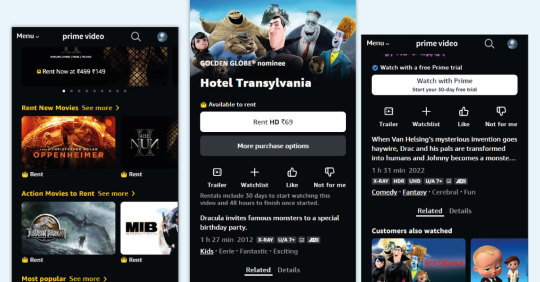
Scraping data from video streaming apps involves extracting diverse fields to capture comprehensive insights into user behavior, content performance, and platform dynamics. Critical data fields for scraping video streaming app data include:
Title and Genre: Capturing the title and genre of each video provides a fundamental understanding of content offerings and user preferences.
Viewership Metrics: Metrics such as the number of views, watch time, and unique viewers shed light on specific content's popularity and engagement levels.
User Ratings and Reviews: Scrutinizing user-generated ratings and reviews offers valuable sentiment analysis, helping to gauge audience satisfaction and preferences.
Recommendation Algorithm Data: Understanding how recommendation algorithms function, including suggested content and personalized recommendations, provides insights into content discovery patterns.
Subscription Data: For subscription-based platforms, scraping subscription-related data, including user plans, subscription rates, and retention metrics, aids in understanding revenue streams and user loyalty.
Device and Location Data: Analyzing the devices used, and geographical locations of users enhances the platform's understanding of its user base, facilitating targeted content delivery.
Content Metadata: Extracting metadata such as cast, crew, release date, and duration contributes to building a comprehensive content database.
Ad Performance Metrics: For ad-supported platforms, scraping data on ad impressions, click-through rates, and advertiser information is crucial for monetization strategies.
User Interaction Data: Tracking user interactions, including likes, shares, and comments, provides insights into user engagement and social interactions on the platform.
Platform Analytics: Scraping data on platform usage, session durations, and user demographics aids in refining user experience and tailoring content strategies.
Streaming platforms can gain actionable insights by meticulously extracting these data fields, enhancing user experiences, and making informed decisions to stay competitive in the dynamic video streaming landscape.
List of Streaming App Scraping Services

Video streaming is vast, with many platforms offering diverse content catering to varied tastes and preferences. Here's a list of notable video streaming apps that have made a significant impact:
Netflix: Netflix, a trailblazer in the streaming industry, features an extensive collection encompassing movies, TV shows, documentaries, and exclusive original content.
Amazon Prime Video: With a mix of licensed and original content, Amazon Prime Video is a significant player in the streaming market, offering a diverse range of entertainment.
Hulu: Known for its extensive collection of current TV shows and next-day access to network series, Hulu is a popular choice for on-demand streaming.
Disney+ Hotstar: Disney+, the preferred platform for family-friendly entertainment, hosts a diverse selection, including Disney classics, Pixar films, Marvel series, and Star Wars content.
HBO Max: Offering a combination of HBO's premium content, WarnerMedia's library, and exclusive originals, HBO Max is a comprehensive streaming service.
Apple TV+: Apple's streaming service features a growing catalog of original content, including movies, documentaries, and series.
Peacock: NBCUniversal's streaming service combines current NBC shows, classic TV, and movies.
Paramount+: Formerly CBS All Access, Paramount+ offers a vast library of CBS content, live TV, and exclusive originals.
YouTube TV: Providing live TV streaming with a wide range of channels, YouTube TV is a popular choice for cord-cutters.
Crave: Crave is a Canadian streaming service offering a mix of HBO content, Showtime, and other popular TV series and movies.
These streaming apps represent just a fraction of the diverse landscape, showcasing the dynamic evolution of how audiences consume content in the digital age. Each platform brings unique content and features, contributing to the vibrant world of video streaming.
The Future Of Video Streaming Apps
The future of video streaming apps is poised for continuous innovation and evolution, driven by technological advancements, changing consumer behaviors, and the dynamic landscape of the entertainment industry. Several vital trends shape the trajectory of video streaming:
Emergence of Immersive Technologies: Augmented Reality (AR) and Virtual Reality (VR) are anticipated to play a pivotal role in enhancing the immersive viewing experience, allowing users to engage with content in new ways.
AI-Driven Personalization: Artificial Intelligence (AI) and machine learning will refine content recommendation algorithms, offering hyper-personalized suggestions based on user preferences, viewing habits, and contextual relevance.
Integration of Social Elements: viewing experiences, such as synchronized watching and interactive features, will become more prominent, fostering a sense of community among users even in the digital realm.
Live Streaming Domains: Beyond traditional on-demand content, live streaming will continue to gain prominence, especially in areas like sports, gaming, and real-time events, offering dynamic and engaging experiences.
5G Revolution: The widespread adoption of 5G technology will enable faster and more reliable streaming, facilitating high-quality video content on mobile devices and ushering in a new era of seamless connectivity.
Original Content Boom: Streaming platforms will invest significantly in creating original and exclusive content to differentiate themselves, leading to a surge in unique and diverse storytelling.
Monetization Strategies: Varied monetization models, including ad-supported, subscription-based, and hybrid models, will continue to evolve as platforms experiment with new ways to generate revenue while providing value to users.
As these trends converge, the future of video streaming apps promises an even more dynamic and personalized landscape, redefining how audiences consume and engage with content in the digital era.
Association Of App Scraping And Video Streaming Apps
The association between App scraping and video streaming apps underscores the dynamic interplay between data extraction and content delivery platforms. App scraping, the process of extracting data from Application, is crucial in several ways, enhancing video streaming apps' functionality and user experience.
Firstly, App scraping enables streaming platforms to gather real-time data on user preferences, viewing habits, and content popularity. This valuable information fuels the development of sophisticated recommendation algorithms, ensuring personalized content suggestions that resonate with individual viewers.
Additionally, App scraping facilitates competitive analysis by tracking the performance and offerings of rival streaming services. This data empowers platforms to make informed decisions about content acquisition, pricing strategies, and user engagement features, ultimately contributing to their competitive edge in the market.
Moreover, app scraping aids in monitoring and optimizing ad placements and user interactions on streaming platforms. Streaming services can refine advertising strategies by analyzing app data and ensuring targeted and effective promotions tailored to user demographics.
In essence, integrating app scraping techniques enhances the strategic decision-making processes within video streaming apps, leading to improved user experiences, content curation, and overall competitiveness in the ever-evolving landscape of digital entertainment.
How Mobile App Scraping Can Help You In Scraping Live Video Streaming Data?
Mobile App Scraping offers specialized expertise in scraping live video streaming data, providing tailored solutions to meet your unique data extraction needs. Here's how Mobile App Scraping can assist you in this domain:
Customized Scraping Solutions: Mobile App Scraping understands that each live video streaming platform has nuances. They offer customized scraping solutions, ensuring that the data extraction process is aligned with the specific requirements and intricacies of the targeted platform.
Real-Time Data Extraction: For live streaming data, timeliness is crucial. Mobile App Scraping employs advanced techniques to enable real-time data extraction, ensuring you have access to the latest and most relevant information as events unfold.
Scalability: Whether you're dealing with a small-scale event or a large-scale live streaming platform, Mobile App Scraping provides scalable scraping solutions. This scalability ensures that the scraping process can efficiently handle varying volumes of data without compromising performance.
Comprehensive Data Fields: Mobile App Scraping can tailor the scraping process to extract a wide range of data fields. This may include information about live viewership, audience engagement, content popularity, and other relevant metrics crucial for a holistic understanding of the streaming landscape.
Adherence to Ethical Standards: Mobile App Scraping prioritizes ethical scraping practices. They ensure compliance with the terms of service of the targeted platforms, respect privacy guidelines, and operate within legal frameworks, providing you with data obtained through ethical means.
Robust Technical Support: The team at Mobile App Scraping offers robust technical support throughout the scraping process. From initial setup to ongoing maintenance, their experts are available to address any technical challenges and ensure the smooth operation of the scraping solution.
By leveraging Mobile App Scraping for scraping live video streaming data, you can gain a competitive edge by making data-informed decisions, understanding audience behaviors, and staying ahead in the dynamic landscape of live streaming platforms.
Conclusion
Entrusting Mobile App Scraping with your live video streaming data scraping needs ensures a service and a strategic partnership dedicated to optimizing your insights and decision-making processes. With customized scraping solutions tailored to the intricacies of each platform, Mobile App Scraping guarantees real-time extraction, scalability, and a comprehensive array of data fields. The commitment to ethical standards ensures that the data obtained is accurate and acquired responsibly, adhering to legal and privacy guidelines
As the dynamic world of live streaming continues to evolve, Mobile App Scraping is your reliable ally, providing robust technical support and adapting to the ever-changing landscape. Make informed decisions, stay ahead of trends, and harness the power of real-time data with Mobile App Scraping. Seize the opportunity to elevate your understanding of live video streaming dynamics and position your endeavors for success. Act now and embark on a data-driven journey with Mobile App Scraping – where your data needs meet unparalleled expertise.
Take the next step towards data-driven excellence. Contact Mobile App Scraping today and unlock the full potential of your live video streaming insights.
know me>> https://www.mobileappscraping.com/scrape-streaming-app-data-from-amazon-prime-netflix-disney-plus-hotstar.php
#ScrapeStreamingAppsData#ExtractStreamingAppsData#StreamingAppsDataScraping#StreamingAppsDataCollection
0 notes
Text
Scrape OTT Media Platform Using Web Scraping
What is OTT Platforms?
There have been massive changes in the platform of OTT. There are many over platforms needed for media services or the apps that we used on mobiles for viewing all the video content. These are the services that are offered to users of the internet. These are the main platforms that have changed in the years. It can be started with Amazon Prime Video Streaming across the world. OTT platforms have changed in such a way that it looks at entertainment. Top on the video demands for the platform that can be used lots of data and can crunch a lot of numbers on different levels so that we can provide perfect content to clients.
There are many platforms like Amazon Prime, Netflix, HotStar is getting scraped, so we are following that process in which you can scrape the data from OTT Media Platforms Crawling. Talking about the data is everywhere and it is used by many companies that will able to make all video content from different clients.
Data Used by OTT Users
Many OTT media platforms provide data. Many examples if you have finished watching all your important shows, that’s the reasoning engine required similar shows. That means platforms and algorithm needs to be designed to suggest the same viewers to content.
Here are 5 main Followed Platforms:
1.Identification & User Segmentation:
Platforms always need to stay ahead. So they need to show them what the next plan is. Many platforms show that the clients are having different offers and discounts that can use for a subscription. There are many unique platforms for all clear users. Users can also choose the plan of their choice and can avail of discount coupons for the same.
2.Lifetime Value of Each User:
Cross-selling is something that can help people to look forward. E.g. Amazon is providing prime membership along with Amazon music and all the other best offers along with the subscription. This will help to increase loyalty regarding the brand and shows interest in longer services. Data analytics can help in many ways like you can identify user trends and you can manage an organization or you can showcase cross-selling promotions to all the related users.
3.Experience Enhancement Users:
They are providing all the personalized that can give a recommendation to all the users they have completed watching all the different shows or channels. Data helps to organize, find, and predict all the recommendations to users. This will help you to increase the large number of variations on the platforms and you can easily able to make unique content.
4.Targeting Advertisement:
This is the complete process which requires from all the different sources. Web Scraping Services is the process that provides quality data to all the companies. The advertisement has to run that promotes different content that provides all different OTT platforms. It helps to increase content views and subscriptions too. Advertisement is a very important and creative source that can immediately help to sign-ups all the various platforms, it can also help to find out all potential customers for different platforms.
5.Accurate Predictions:
Many offers and sales are there for a subscription that can help to boost the sale of subscription plans that is offered by OTT platforms. Web Scraping Data is useful in many such cases where the data is given priority to organize to make deep analysis statistics over the valuable information for giving data.
Customers Success and Insights
It helps to collaborate all the approaches that can understand all the requirements in the terms of different sources of the data, the volume of data, the data models, velocity of data, and variety of data. Using different inputs, an organization like Amazon Prime, Netflix, Hot Star, will able to create a large impact on the enterprise level. It can also create a pipeline for all the business intelligence once the analysis is done.
Being the Pioneer
Companies like Amazon Prime, Netflix, Hot Star, do a lot of research for the clients. Demanding for videos on demanding OTT platforms; is depending to stay ahead of all the games which are being seen in the field. We provide all the different content creators the freedom so that anyone can work for different content and various clients across different sites. There are around 3.6 million people who have joined free plans to a paid subscription.
How OTT Platforms use Data for Personalize
These are all giant seek companies with over 500 million subscriptions that give you a lot of ideas for proportion. The personalization of different content that begins with all the data focus on the following details:
Content Nature:
The content of nature is being seen by different sources. This will identify that generates different content that is being watched by all the other users across the globe.
Ratings:
The ratings are the major factor for all movies and shows. Ratings are the main determination that helps to get a season or a sequel. This can also help to create content that needs to understand all the specific clients.
Location:
There are important platforms that show ads and recommendations in all the local languages. This can help in increasing the subscriber and subscription both that sets by the companies.
Some important Data-Points:
Some Data points help content that understands the clients. These will help to increase capability in such boundaries. These offer the best job difference to assist across all the industries which need to be targeted.
Conclusion
The road map of OTT platforms depends on long and hard. They need to capture the mindset of most client’s visits. The days which spend on the traditional set-up boxes and all TV cables and channels. OTT and Apps are the procurement scene, and it looks much good in the nearest future. These are the platforms that need to require data that is public.
1 note
·
View note
Text
What is Scrape YouTube Netflix Tiktok Data Services?
The quality of insights as well as end results of the data application is completely reliant on the data quality and that’s why at iWeb Scraping, we provide the best video app scraping services.
What is Video Streaming?
Video streaming is one kind of media streaming where data from a video file is constantly delivered through the Internet to its remote user. This helps a video to get viewed online without getting downloaded on the host device or computer.
The market of video live streaming market is increasing at a brisk pace. In 2016, the industry had reached $30 billion and it’s projected to become more than double by 2021 to reach over $70 billion. Around 81% of Internet users view live-streamed content. In fact, around 63% of people between 18-34 years age watch live-streaming content on a regular basis. Even older people between 35-54 years are creating as well as using their personal live-stream videos!
Video apps like Amazon Prime Video, HBO Now, Hulu, Movies Anywhere, Netflix, Sony PlayStation Vue, Sling TV, Twitch, YouTube, Philo TV, Sony Interactive, Fubo TV, CBS All Access, Crackle, Vevo, Popcornflix, Viewster, Vimeo, and Hotstar have become very popular for live-streaming videos.
Membership of these video apps provides you access to unlimited movies and TV shows at a monthly price. With these video apps, you can immediately watch as many movies and TV episodes as you want anytime. You can search through the selection of thousands of movie and serial titles. You can search titles and immediately watch them on your Smartphone. You can rate your favorite movies and shows and Web Scraping Services.

Listing Of Data Fields
At iWeb Scraping, we do Video App Data Scraping by scraping the following data fields’ categories:
Video Name
Video Title
Video URL
Video Description
Video Meta Title
Video Meta Description
Channel Name
Total Views
Likes
Dislikes
Share
Downloads
Trending
Subscriptions
1 note
·
View note
Text
PYTHON PROGRAMMING: TOP 12 APPLICATIONS OF PYTHON IN BUSINESS

The developer community knows that Python programming is becoming the mainstream. This programming language is one of the most popular ever and continues to disrupt many industries. Considering the plethora of use cases it has, makes it a highly preferred programming language amongst the developers.
It supports both functional and object-oriented programming approaches. From web development to deep learning and neural networking, its uses are on the rise. In this blog, we will walk you through 12 real-world use cases of Python where this language is making waves in 2021.
Without further ado, let’s get started!
Top 12 Real-World Use Cases Of Python Machine Learning Apps
Python, as compared to Java or C++, has a simpler syntax and is more preferred for developing machine learning applications and platforms. Python programming allows the developers to handle tremendously large amounts of data and makes it a better choice when developing machine learning applications.
Scipy and Numpy are the two libraries used for technical computing. Panda, a data manipulation tool, helps the developers with in-depth data analysis. Scikit is another tool that is used for building machine learning applications.
AI
Artificial intelligence is probably the most interesting use case for Machine Learning and Python. This is because Python is powerful and stable enough to handle the computations that are required for developing Machine Learning models. With a suite of useful libraries, developers can write Machine Learning algorithms using the Python Language. The developers use Pandas, SciPy, TensorFlow, NumPy, Keras, and other libraries to develop ML applications.
Python programming also has several use cases in the AI space including data analytics, image recognition, text processing, advanced computing and many more. These are some evergreen areas that businesses can profit from.
OS Development
Python programming is paving the way for several operating systems. The Linux-based Ubiquity and Anaconda installers are coded in Python. Even Gentoo Linux leverages the Python package management system. Developers generally combine Python with the C language to develop different operating systems.
Web Scraping Applications
Python programming is pivotal for extracting tremendous amounts of data from websites and web pages. The data extracted is used in different operations including price comparison, R&D, job boards, marketing, market prediction, and many more. This data can be used in different industries to emphasize multiple verticals of the business.
These are some of the popular web scraping tools available:
MechanicalSoup
Scrapy
Python Requests
Selenium
Urllib
LXML
Web Development
Web development is an important pillar for most businesses and Python offers a plethora of development options. You can get access to Django, Bottle, Pyramid, and Flask for developing web frameworks and applications. Apart from that, you can also use powerful and advanced content management systems like Django CMS and Plone. These powerful frameworks are packed with modules and standard libraries that simplify the operations such as database interaction, content management and interfacing with protocols like XML, IMAP, POP, FTP and more.
Data Science & Solutions
Python plays a very important role in shaping data-driven companies such as Google, Spotify, DBS Bank, Netflix and a whole lot. The powerful search options in Netflix offers a unique experience with Python-driven data insights. Recommendations and suggestions are based on a recommendation system that is a powerful machine learning algorithm.
Scientific & Numeric Applications
Python plays a crucial role in numeric and scientific computing. It offers a supportive environment for applications that deal in scientific data processing and computation. Such applications include the finite element approach Abaqus FreeCAD (computer-aided designing).
Game Development
Python supports game development. Pygame is a developer-friendly library that enables developers to develop 2D and 3D games. Starting with Python is very easy and it allows the developers to leverage tons of libraries for quick prototyping.
Apart from game development, developers can also use Python for developing tools to simplify specific actions, design a dialog tree, environment designing, asset management, generate levels of detail (LODs) and support content in level. This powerful language can also export these actions in the game engine. Python supports the Unreal engine.
Language Development
Over several years, the module and design architecture of Python has paved the way for the development of new programming languages including Swift, Cobra, OCaml, CoffeeScript and many more. All these are powerful programming languages and share several similarities with Python such as syntax, indentation, and object model.
Internet Of Things
Internet of Things is another real-life use of Python for business. With Python programming, developers can turn any object into an electronic device with the help of Raspberry Pi. Using Raspberry Pi, developers can create embedded software that enables python programming on smaller objects that can work with powerful programming languages.
Raspberry Pi helps the developers to perform high-level computations and turn normal objects into electronics to design an environment of IoT. In larger industries, IoT is used to track inventory, movie and manage machines, track order processing, check the shipment status and fleet management.
Enterprise Applications
Enterprise applications are poles apart from regular web applications. Enterprise-grade applications are designed to serve the big needs of the entire organization. These apps can sometimes be very complex with database handling requirements and security needs. Python programming can handle multiple database requests at a time. Considering its versatile nature, Python is used for scalability, functionality and readability.
Developers can easily leverage the libraries to develop different enterprise-grade applications. Tryton and Odoo are some of the popular enterprise application development tools that work in tandem with Python. Enterprise applications are the most significant uses of Python for business in 2021.
Ed-Tech
Ed Tech is another industry powered by Python programming. Online courses, programs, quizzes, and interactive content are a few elements that are developed using Python. This programming language is beginner-friendly and offers tons of helpful features with a simple learning curve. The syntax of this powerful language is very similar to English and due to this, it finds yet another real-world case in the Ed Tech market. Python programming is used to develop education programs, interactive quizzes, and training courses.
Due to the high scalability and compatibility with Machine Learning, Python can offer tons of useful features to design events and decision-based gamification for modern learners.
Final Words
Tons of libraries, high scalability and powerful architecture are some reasons why Python is growing at a supersonic speed. Apart from these elements, dynamic typing, built-in data structures, frameworks, powerful libraries, and huge community support are a few other pillars that make Python programming the developers’ choice for developing some of the best applications in the evolving marketplace.
Python can handle tons of data requests at a time and this feature makes it useful for all kinds of app development. From enterprise apps to AR VR gaming projects and IoT, Python programming is the key to unlocking potential business horizons and is making huge waves in 2021. At DRC Systems, we are on a mission to fast-track your idea in the digital era using Python. Contact us right away to know how our dedicated Python developers and domain specialists can digitally transform your business.
0 notes
Text
Future Programming Languages 2025 2030
Which is best Future Programming Languages 2025 2030. When programmers are about to start their coding journey, it is difficult to decide on where to start. Here is a list of the future technology programming languages having a high demand in 2025 and 2030.
What are the Future Programming Languages 2025 2030 technology having a high demand in 2025 and 2030
Swift
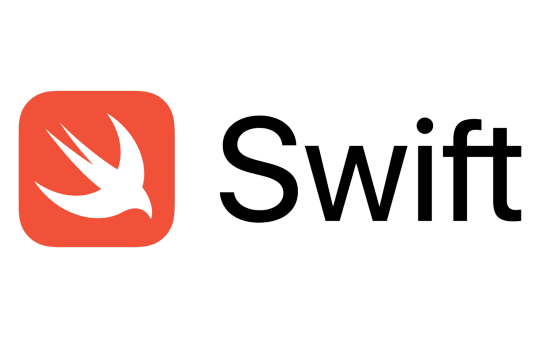
If you are a mobile developer, Swift is perfect for you! Apple developed it for creating IOS and Mac OS Applications. it remains one of the most in-demand languages of 2021 and will continue to have a high demand in 2025 and also 2030. Swift is also easy to learn and supports almost everything from objective-C. It is a general-purpose, multi-program compiled programming language. It's Mac-base and if you become good with it, then it's easier to make more money than Android developers. Swift is fast, efficient, secure, enables a high level of interactivity by combining forefront language features. It is a general-purpose programming language built using a modern approach to safety performance and software design patterns. The goal of the swift project is to create the best language for users ranging from systems programming to mobile and also desktop apps scaling up to cloud services. Companies using Swift- Apple, Lyft, Uber. Python

Python is undoubtedly a Powerhouse. Its applications extend in many domains like web development, data science, data visualisation, machine learning, artificial intelligence web scraping and also others. It is one of the most popular languages and it is very easy to learn with a vast community and many open source projects. The drawbacks are mainly its slow interpretation since it is a high level language. Python is on top of the job demands and also it has the highest average wages in the tech industry. It is easy to learn. This programming language is great for beginners. It is often use as a scripting language for web applications. Python is the lingua franca of machine learning and also data science. Python's popularity Rose by 3.48% which is very impressive. In Python, coding are the dynamic type. In coding, you don't need to declare the type of variable. The syntax of python is easy to remember, almost similar to human language. Companies using Python- Instagram, Amazon, Facebook and Spotify. Java
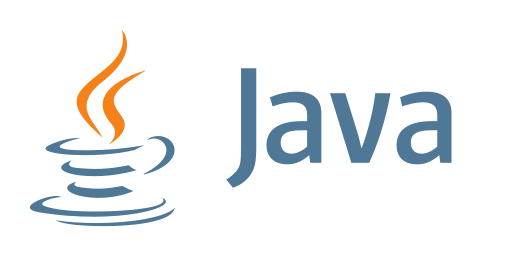
Firstly, Java is the leading enterprise programming language at the moment. Java will also be high in demand in 2025 and 2030. It is a general-purpose language use for web pages, and much more and also is the Android dominant language, and it is powerful. It supports distributed computing and multi-threading. And also It is very secure, and it Moves the biggest Enterprises and data centers globally. Today 15 billion devices run Java, and it is being use by 10 million developers worldwide. It is freely accessible and we can run it on all the platforms of the operating systems. Java is best for embedded and also cross-platform applications. Java has a larger number of frameworks and has long lines of code. It is use to develop desktop and mobile applications, big data processing, embedded systems, and so on. Companies using Java- Uber, Netflix, Instagram, Google Kotlin

The effortless interoperation between Java and Kotlin Android development is faster and also enjoyable. Scotland addresses the major issues that surfaced in Java, developers have rewritten several Java apps in Kotlin. The syntax is easy to learn for beginners and also it offers a host of powerful features. It can be a great language to upskill for experienced programmers. It has a Shallow learning curve especially if you have experience in Python or Java. Kotlin is a cross-platform, statically typed, general-purpose programming language with Type inference. It is develop to inter-operate completely with Java. Recently, Google announced that Android development will be increasingly Kotlin- first and that many top apps have already migrated to Kotlin. Companies using Kotlin- Courser, Uber, Pinterest. JavaScript

It is the most popular language according to a Stack overflow survey. It is widely know for adding interactive elements to web applications and also browsers. JavaScript is the ultimate language of the web. Almost every web and also mobile application run JavaScript. Since it is a client-side language, many simple applications don't need server support and in the case of complex applications, it produces a server load. There is an insane growth in the usage of this language as well. And also It is also the foundation of most libraries and frameworks for the web surcharge React, Vue and Node. It can run inside nearly all modern web browsers. It is a programming language used primarily by web browsers to create a dynamic and also interactive experience for the users. Companies using JavaScript- PayPal, Google, Microsoft Rust

Rest is a multi-paradigm programming language focused on performance and safety. Rust is syntactically similar to C++. It offers the safety of memory with no use of garbage collection. Rust has great documentation. A friendly compiler with useful error messages and top-notch tooling- an integrated package manager and also build tool. Rust is the language of the future. And also It is the most loved language and one of the highest paying languages in the world. It empowers everyone to build reliable and efficient software. It has the speed and also low-level access of languages like C/C++ with memory security like modern languages. This programming language can run on embedded devices. Rust can easily integrate with other languages. Hundreds of companies Around The World are using rust in production today for fast, low-resource, cross-platform solutions. Companies using Rust- Dropbox, Figma, Discord C++
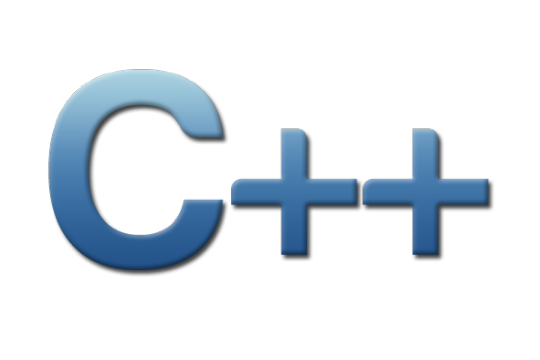
Firslty, It is a powerful general-purpose programming language. It can develop operating systems, browsers, games, and so on. C++ supports different ways of programming like procedural, object-oriented, functional, and so on. This makes C++ powerful as well as flexible. C++ is old but gold. It is highly use for professional software game development and also high-performance applications. This includes machine learning. It gives programmers a high level of control over the system's resources and memory. We can find this language in today's operating system, graphical user interface, and also embedded systems. It is close to C# and Java; it makes it easy for programmers to switch to C++ or vice versa. And also was develop as an enhancement of the C language to include an object-orient paradigm.�� Companies using C++ - Evernote, Microsoft, Opera, Facebook PHP PHP is a popular general-purpose scripting language that is especially suit for web development. Fast, flexible and pragmatic, PHP powers everything from your blog to the most popular websites in the world. Statistics show that 80% of the top 10 million websites. It creates, reads, opens, deletes, and also closes files on the server. It controls user access and also encrypts data. A wonderful benefit of using PHP is that it can interact with many database languages including my SQL. PHP is free to download and use. And also It is powerful enough to be at the core of the biggest blogging system on the web- WordPress! It is compatible with almost all servers use today like Apache, IIS, and others. It is deep enough to run the largest social network- Facebook. PHP can be easily embed in HTML files and HTML code can also be write in a PHP file. Companies using PHP- Facebook, Tumblr, Etsy, WordPress C#

C-Sharp is a programming language developed by Microsoft. It runs on the .NET framework. It is use to develop web apps, desktop apps, games, and also much more. Microsoft developed C Sharp as a rival to Java. It is highly use in the enterprise environment and also for game development with the Unity engine. C# gives its free hand to create applications not only for Websites but also for mobile applications. Although it has common points with structure programming languages, it is accept as an object-oriented programming language. There are a massive number of out-of-the-box solutions that you can find in this Programming language but not in other programming languages. For example, tools for unit testing, crypto library, Marvellous collections handling and multi-threading. Companies using C#- CarMax, RTX, Twitch Scala
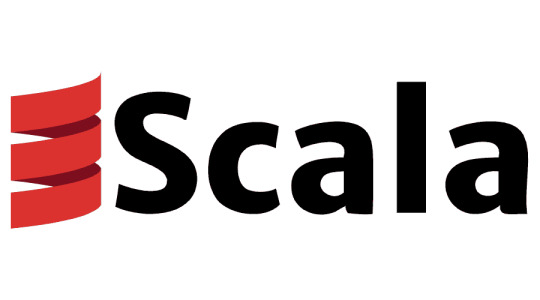
Scala is a programming language that combines Object-oriented programming with functional programming. And also It has a strong static type system and is design to be concise. It operates on the JVM. Also, It is a hybrid of two Programming Paradigms. It tries to address all the criticisms of Java, in which you can keep all the Java libraries and all the advantages of the JVM. At the same time, your code is more concise. Scala is oftentimes use in data science. Scala is a very compatible language and can be very easily install into windows and the Unix operating system easily. This language is useful for developers to enhance their business applications to be more productive, scalable, and reliable. There is no concept of primitive data as everything is an object in Scala. It is design to express the general programming patterns in a refine, succinct, and type-safety way. Companies Using Scala- Netflix, Sony, Twitter, Linkedin
5 Best Practices for Writing Better Code
Naming conventions In computer programming, a naming convention is a set of rules for choosing the character sequence to be use for identifiers that denote variables, types, functions, and other entities in source code and documentation. Three Types of naming conventions are: - Camel case - Pascal case - UnderScores Commenting In computer programming, a comment is a programmer-readable explanation or annotation in the source code for a computer program. We all think our code makes sense, especially if it works but someone else might not to combat this, we all need to get better at source code commenting. Indentation There are no criteria of following any indentation. The best method is a consistent style. Once you start competing in large projects you will immediately understand the importance of consistent code styling. Follow DRY principle DRY- Don't Repeat Yourself It should not repeat the same piece of code over and over again. How to achieve DRY? To avoid violating this principle, break your system into pieces. Dissect your code and logic. Break them into smaller reusable units. Don't write lengthy methods. Try to divide the logic and use the existing peace in your method. Follow KIS principle KIS- Keep It Simple After all, programming languages are for humans to understand, computers can only understand 0 and 1. So, keep coding simple and straightforward. How to achieve KIS? To avoid violating this principle, Try to write simple code. Think of many solutions for your problem then choose the best simplest one and transform that into your code. Whenever programmers face lengthy code, convert it into multiple methods, right-click and reactor in the editor. Try to write small blocks of code that do a single task. Recent Articles: Future Programming Languages 2025 2030 Benefits of Using Angular for Web Development 2021 Difference Between C vs C++ vs Python vs Java KALI Linux Not Prefer Software Development Ubuntu Angular 12 Performance Benchmark Install Features Setup Angular 12 vs 11 vs 10 features benchmark How to Write Business Proposal for Client with Sample Format Top 10 Best Coolest Movies Chris Hemsworth of all time Future Programming Languages 2025 2030 - Writer Taniya Patyal Read the full article
#FutureProgrammingLanguages#FutureProgrammingLanguages2025#FutureProgrammingLanguages20252030#FutureProgrammingLanguages2030
0 notes